Effective Strategies for Managing Human Resources: An Essay
VerifiedAdded on 2021/05/05
|12
|3210
|62
Essay
AI Summary
This essay delves into the critical aspects of human resource management, focusing on the concept of total rewards and its influence on employee motivation and organizational performance. It examines how rewards, encompassing financial returns, tangible benefits, and services, are structured and implemented within organizations. The essay explores the relationship between total rewards and various motivational theories, including Maslow's hierarchy of needs, Alderfer's ERG theory, and equity theory. It analyzes how these theories explain employee behavior and how reward systems can be designed to align with employee needs and expectations. Furthermore, the essay evaluates the effectiveness of total rewards systems across different employment sectors, such as the insurance industry, highlighting the importance of adapting strategies to specific industry contexts and organizational goals. It discusses the benefits of well-designed reward systems, including improved employee performance, retention, and program administration.
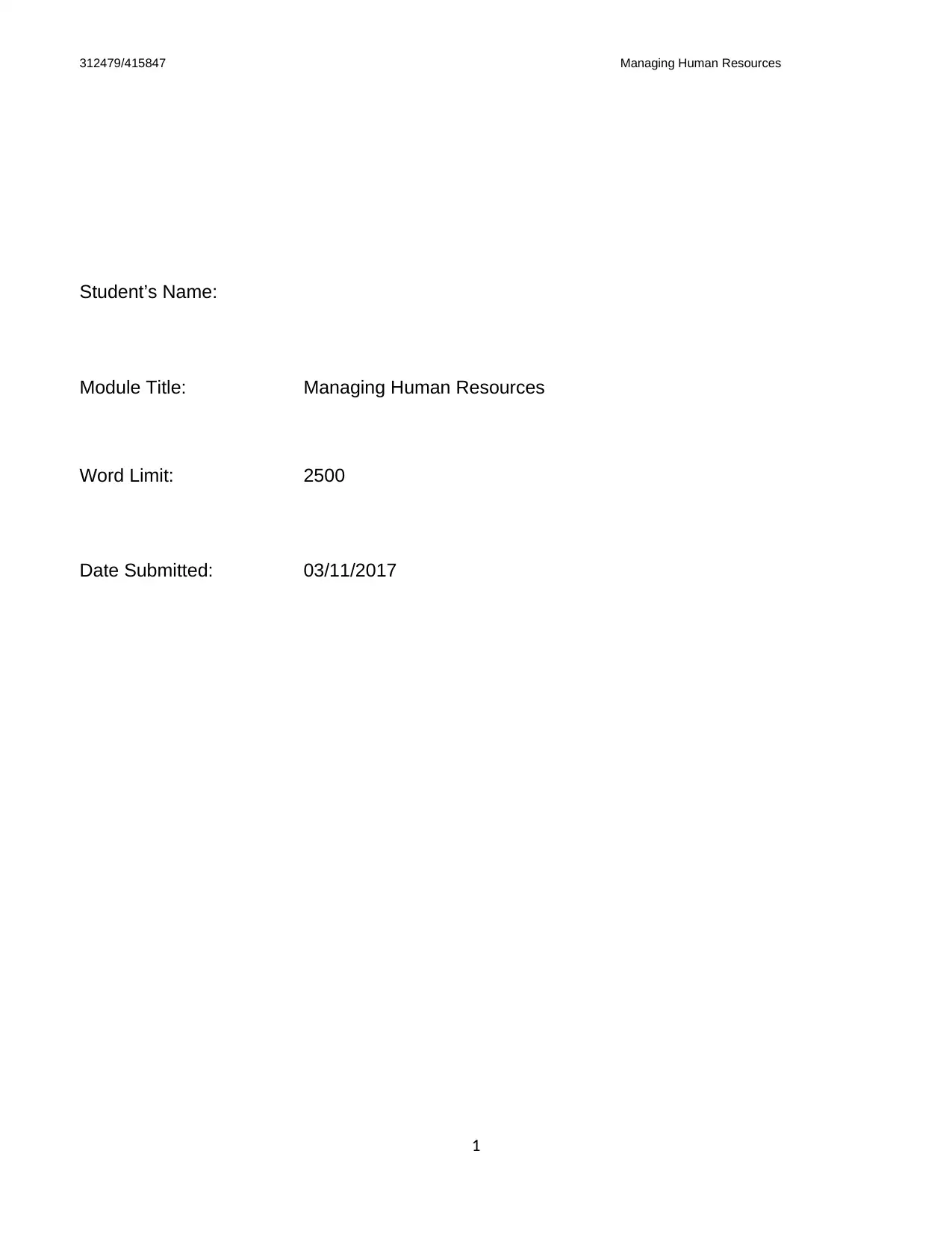
312479/415847 Managing Human Resources
Student’s Name:
Module Title: Managing Human Resources
Word Limit: 2500
Date Submitted: 03/11/2017
1
Student’s Name:
Module Title: Managing Human Resources
Word Limit: 2500
Date Submitted: 03/11/2017
1
Paraphrase This Document
Need a fresh take? Get an instant paraphrase of this document with our AI Paraphraser
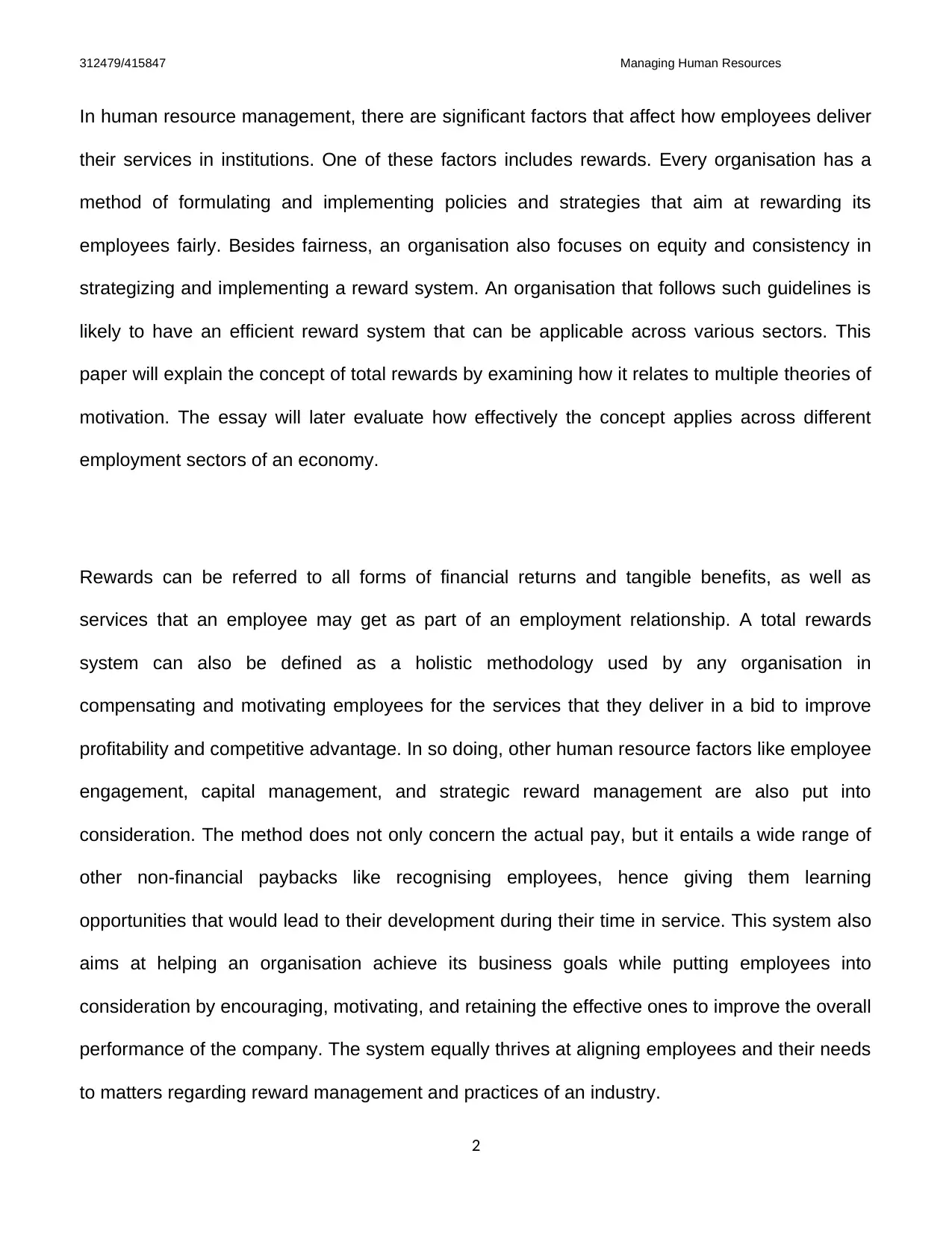
312479/415847 Managing Human Resources
In human resource management, there are significant factors that affect how employees deliver
their services in institutions. One of these factors includes rewards. Every organisation has a
method of formulating and implementing policies and strategies that aim at rewarding its
employees fairly. Besides fairness, an organisation also focuses on equity and consistency in
strategizing and implementing a reward system. An organisation that follows such guidelines is
likely to have an efficient reward system that can be applicable across various sectors. This
paper will explain the concept of total rewards by examining how it relates to multiple theories of
motivation. The essay will later evaluate how effectively the concept applies across different
employment sectors of an economy.
Rewards can be referred to all forms of financial returns and tangible benefits, as well as
services that an employee may get as part of an employment relationship. A total rewards
system can also be defined as a holistic methodology used by any organisation in
compensating and motivating employees for the services that they deliver in a bid to improve
profitability and competitive advantage. In so doing, other human resource factors like employee
engagement, capital management, and strategic reward management are also put into
consideration. The method does not only concern the actual pay, but it entails a wide range of
other non-financial paybacks like recognising employees, hence giving them learning
opportunities that would lead to their development during their time in service. This system also
aims at helping an organisation achieve its business goals while putting employees into
consideration by encouraging, motivating, and retaining the effective ones to improve the overall
performance of the company. The system equally thrives at aligning employees and their needs
to matters regarding reward management and practices of an industry.
2
In human resource management, there are significant factors that affect how employees deliver
their services in institutions. One of these factors includes rewards. Every organisation has a
method of formulating and implementing policies and strategies that aim at rewarding its
employees fairly. Besides fairness, an organisation also focuses on equity and consistency in
strategizing and implementing a reward system. An organisation that follows such guidelines is
likely to have an efficient reward system that can be applicable across various sectors. This
paper will explain the concept of total rewards by examining how it relates to multiple theories of
motivation. The essay will later evaluate how effectively the concept applies across different
employment sectors of an economy.
Rewards can be referred to all forms of financial returns and tangible benefits, as well as
services that an employee may get as part of an employment relationship. A total rewards
system can also be defined as a holistic methodology used by any organisation in
compensating and motivating employees for the services that they deliver in a bid to improve
profitability and competitive advantage. In so doing, other human resource factors like employee
engagement, capital management, and strategic reward management are also put into
consideration. The method does not only concern the actual pay, but it entails a wide range of
other non-financial paybacks like recognising employees, hence giving them learning
opportunities that would lead to their development during their time in service. This system also
aims at helping an organisation achieve its business goals while putting employees into
consideration by encouraging, motivating, and retaining the effective ones to improve the overall
performance of the company. The system equally thrives at aligning employees and their needs
to matters regarding reward management and practices of an industry.
2
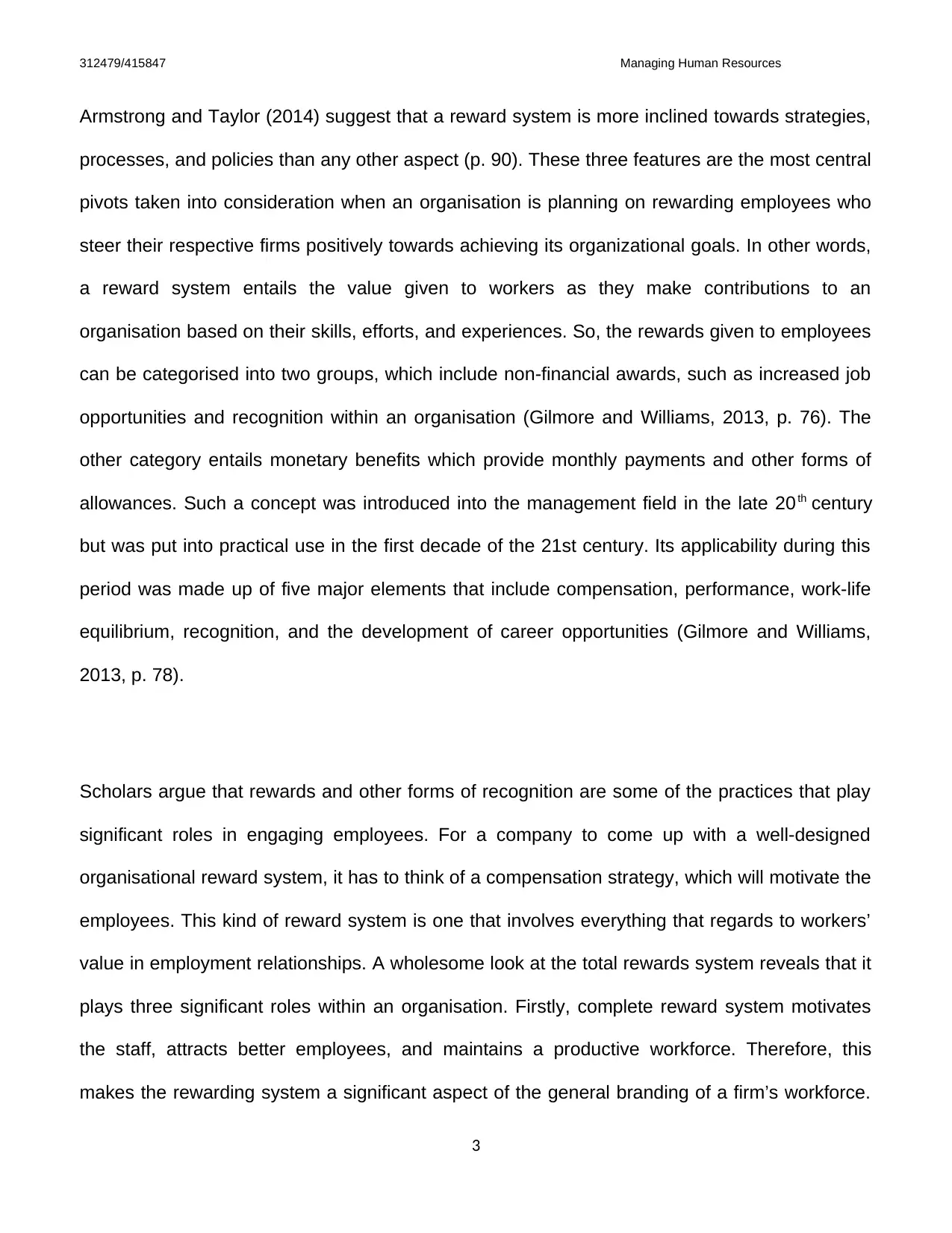
312479/415847 Managing Human Resources
Armstrong and Taylor (2014) suggest that a reward system is more inclined towards strategies,
processes, and policies than any other aspect (p. 90). These three features are the most central
pivots taken into consideration when an organisation is planning on rewarding employees who
steer their respective firms positively towards achieving its organizational goals. In other words,
a reward system entails the value given to workers as they make contributions to an
organisation based on their skills, efforts, and experiences. So, the rewards given to employees
can be categorised into two groups, which include non-financial awards, such as increased job
opportunities and recognition within an organisation (Gilmore and Williams, 2013, p. 76). The
other category entails monetary benefits which provide monthly payments and other forms of
allowances. Such a concept was introduced into the management field in the late 20th century
but was put into practical use in the first decade of the 21st century. Its applicability during this
period was made up of five major elements that include compensation, performance, work-life
equilibrium, recognition, and the development of career opportunities (Gilmore and Williams,
2013, p. 78).
Scholars argue that rewards and other forms of recognition are some of the practices that play
significant roles in engaging employees. For a company to come up with a well-designed
organisational reward system, it has to think of a compensation strategy, which will motivate the
employees. This kind of reward system is one that involves everything that regards to workers’
value in employment relationships. A wholesome look at the total rewards system reveals that it
plays three significant roles within an organisation. Firstly, complete reward system motivates
the staff, attracts better employees, and maintains a productive workforce. Therefore, this
makes the rewarding system a significant aspect of the general branding of a firm’s workforce.
3
Armstrong and Taylor (2014) suggest that a reward system is more inclined towards strategies,
processes, and policies than any other aspect (p. 90). These three features are the most central
pivots taken into consideration when an organisation is planning on rewarding employees who
steer their respective firms positively towards achieving its organizational goals. In other words,
a reward system entails the value given to workers as they make contributions to an
organisation based on their skills, efforts, and experiences. So, the rewards given to employees
can be categorised into two groups, which include non-financial awards, such as increased job
opportunities and recognition within an organisation (Gilmore and Williams, 2013, p. 76). The
other category entails monetary benefits which provide monthly payments and other forms of
allowances. Such a concept was introduced into the management field in the late 20th century
but was put into practical use in the first decade of the 21st century. Its applicability during this
period was made up of five major elements that include compensation, performance, work-life
equilibrium, recognition, and the development of career opportunities (Gilmore and Williams,
2013, p. 78).
Scholars argue that rewards and other forms of recognition are some of the practices that play
significant roles in engaging employees. For a company to come up with a well-designed
organisational reward system, it has to think of a compensation strategy, which will motivate the
employees. This kind of reward system is one that involves everything that regards to workers’
value in employment relationships. A wholesome look at the total rewards system reveals that it
plays three significant roles within an organisation. Firstly, complete reward system motivates
the staff, attracts better employees, and maintains a productive workforce. Therefore, this
makes the rewarding system a significant aspect of the general branding of a firm’s workforce.
3
⊘ This is a preview!⊘
Do you want full access?
Subscribe today to unlock all pages.

Trusted by 1+ million students worldwide
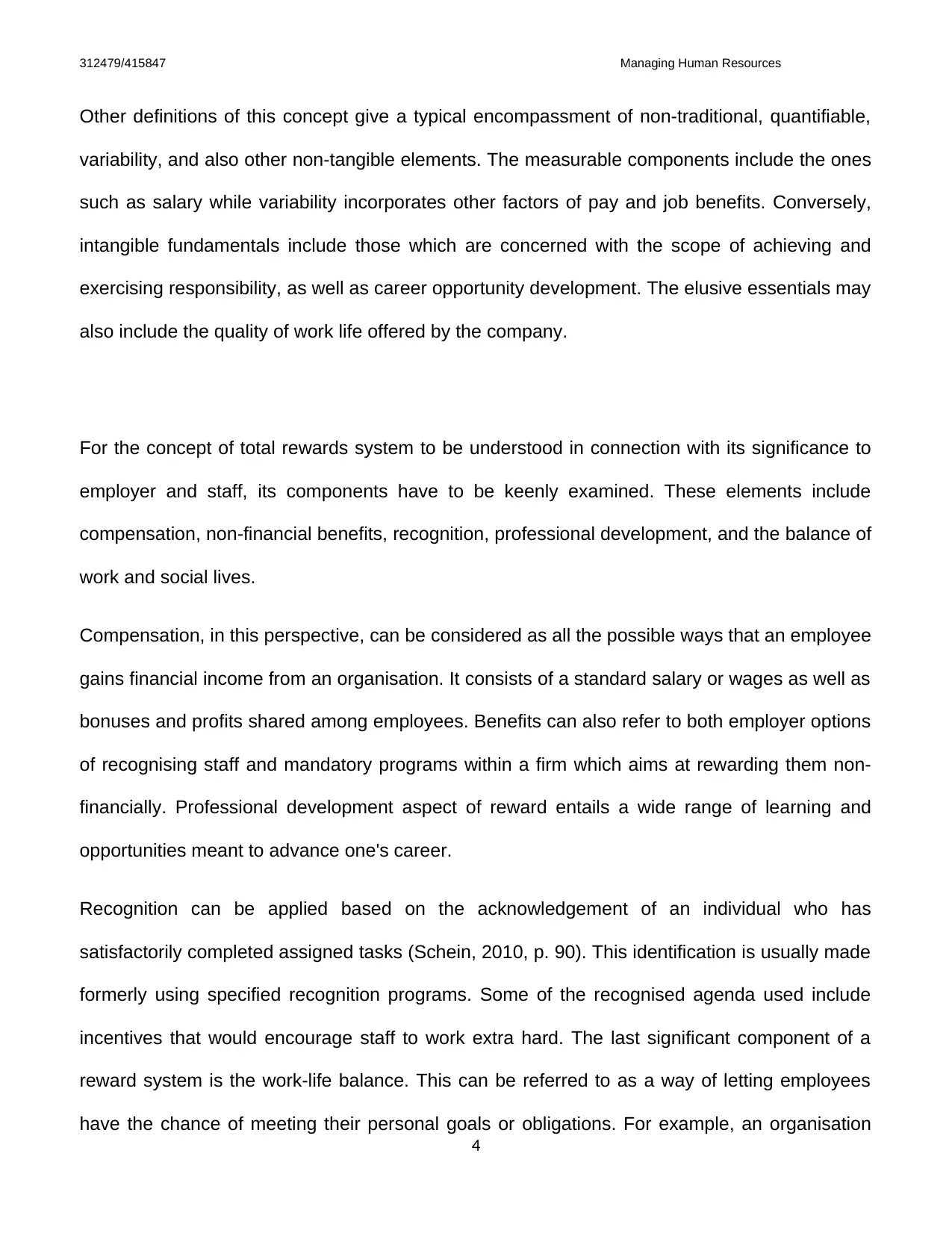
312479/415847 Managing Human Resources
Other definitions of this concept give a typical encompassment of non-traditional, quantifiable,
variability, and also other non-tangible elements. The measurable components include the ones
such as salary while variability incorporates other factors of pay and job benefits. Conversely,
intangible fundamentals include those which are concerned with the scope of achieving and
exercising responsibility, as well as career opportunity development. The elusive essentials may
also include the quality of work life offered by the company.
For the concept of total rewards system to be understood in connection with its significance to
employer and staff, its components have to be keenly examined. These elements include
compensation, non-financial benefits, recognition, professional development, and the balance of
work and social lives.
Compensation, in this perspective, can be considered as all the possible ways that an employee
gains financial income from an organisation. It consists of a standard salary or wages as well as
bonuses and profits shared among employees. Benefits can also refer to both employer options
of recognising staff and mandatory programs within a firm which aims at rewarding them non-
financially. Professional development aspect of reward entails a wide range of learning and
opportunities meant to advance one's career.
Recognition can be applied based on the acknowledgement of an individual who has
satisfactorily completed assigned tasks (Schein, 2010, p. 90). This identification is usually made
formerly using specified recognition programs. Some of the recognised agenda used include
incentives that would encourage staff to work extra hard. The last significant component of a
reward system is the work-life balance. This can be referred to as a way of letting employees
have the chance of meeting their personal goals or obligations. For example, an organisation
4
Other definitions of this concept give a typical encompassment of non-traditional, quantifiable,
variability, and also other non-tangible elements. The measurable components include the ones
such as salary while variability incorporates other factors of pay and job benefits. Conversely,
intangible fundamentals include those which are concerned with the scope of achieving and
exercising responsibility, as well as career opportunity development. The elusive essentials may
also include the quality of work life offered by the company.
For the concept of total rewards system to be understood in connection with its significance to
employer and staff, its components have to be keenly examined. These elements include
compensation, non-financial benefits, recognition, professional development, and the balance of
work and social lives.
Compensation, in this perspective, can be considered as all the possible ways that an employee
gains financial income from an organisation. It consists of a standard salary or wages as well as
bonuses and profits shared among employees. Benefits can also refer to both employer options
of recognising staff and mandatory programs within a firm which aims at rewarding them non-
financially. Professional development aspect of reward entails a wide range of learning and
opportunities meant to advance one's career.
Recognition can be applied based on the acknowledgement of an individual who has
satisfactorily completed assigned tasks (Schein, 2010, p. 90). This identification is usually made
formerly using specified recognition programs. Some of the recognised agenda used include
incentives that would encourage staff to work extra hard. The last significant component of a
reward system is the work-life balance. This can be referred to as a way of letting employees
have the chance of meeting their personal goals or obligations. For example, an organisation
4
Paraphrase This Document
Need a fresh take? Get an instant paraphrase of this document with our AI Paraphraser
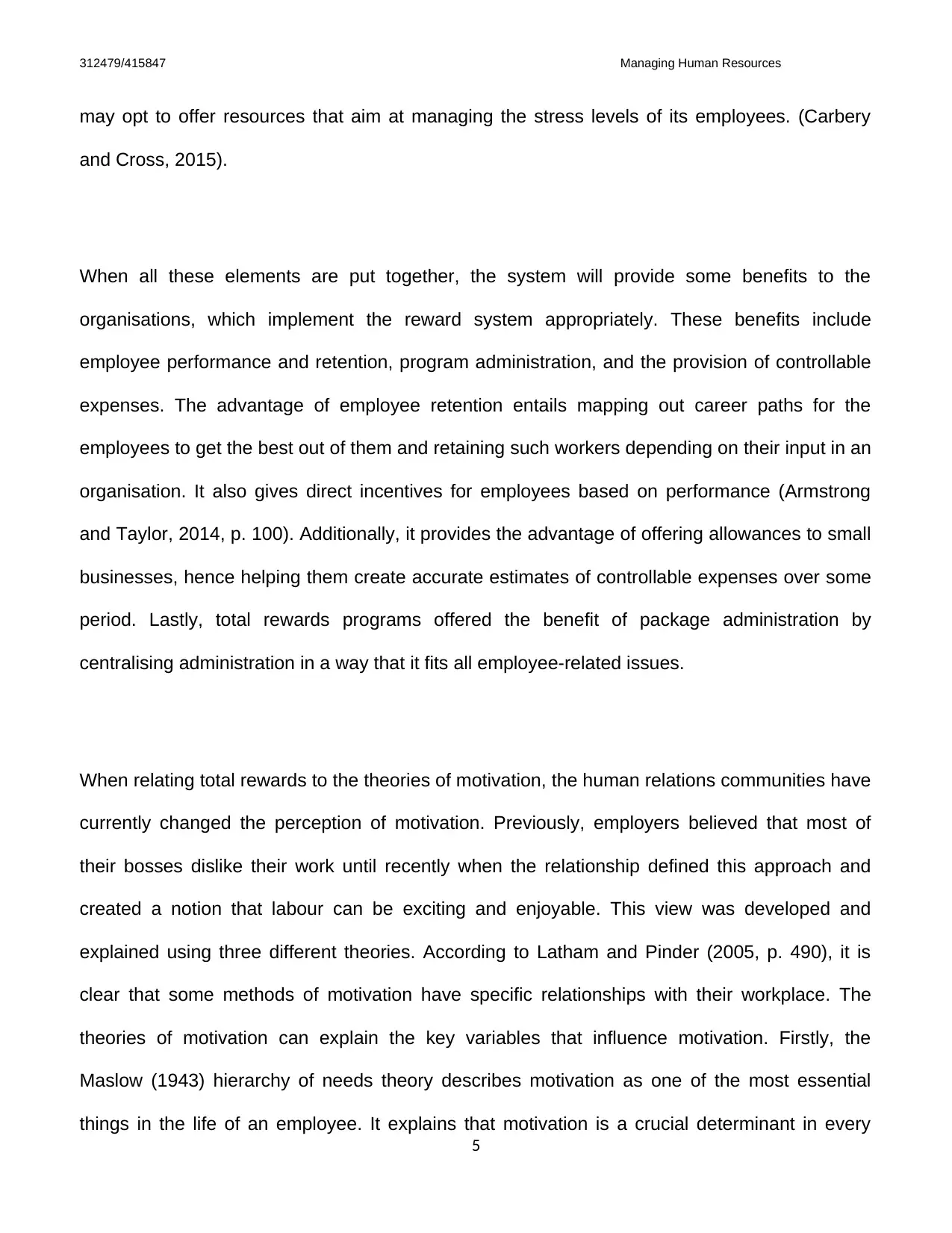
312479/415847 Managing Human Resources
may opt to offer resources that aim at managing the stress levels of its employees. (Carbery
and Cross, 2015).
When all these elements are put together, the system will provide some benefits to the
organisations, which implement the reward system appropriately. These benefits include
employee performance and retention, program administration, and the provision of controllable
expenses. The advantage of employee retention entails mapping out career paths for the
employees to get the best out of them and retaining such workers depending on their input in an
organisation. It also gives direct incentives for employees based on performance (Armstrong
and Taylor, 2014, p. 100). Additionally, it provides the advantage of offering allowances to small
businesses, hence helping them create accurate estimates of controllable expenses over some
period. Lastly, total rewards programs offered the benefit of package administration by
centralising administration in a way that it fits all employee-related issues.
When relating total rewards to the theories of motivation, the human relations communities have
currently changed the perception of motivation. Previously, employers believed that most of
their bosses dislike their work until recently when the relationship defined this approach and
created a notion that labour can be exciting and enjoyable. This view was developed and
explained using three different theories. According to Latham and Pinder (2005, p. 490), it is
clear that some methods of motivation have specific relationships with their workplace. The
theories of motivation can explain the key variables that influence motivation. Firstly, the
Maslow (1943) hierarchy of needs theory describes motivation as one of the most essential
things in the life of an employee. It explains that motivation is a crucial determinant in every
5
may opt to offer resources that aim at managing the stress levels of its employees. (Carbery
and Cross, 2015).
When all these elements are put together, the system will provide some benefits to the
organisations, which implement the reward system appropriately. These benefits include
employee performance and retention, program administration, and the provision of controllable
expenses. The advantage of employee retention entails mapping out career paths for the
employees to get the best out of them and retaining such workers depending on their input in an
organisation. It also gives direct incentives for employees based on performance (Armstrong
and Taylor, 2014, p. 100). Additionally, it provides the advantage of offering allowances to small
businesses, hence helping them create accurate estimates of controllable expenses over some
period. Lastly, total rewards programs offered the benefit of package administration by
centralising administration in a way that it fits all employee-related issues.
When relating total rewards to the theories of motivation, the human relations communities have
currently changed the perception of motivation. Previously, employers believed that most of
their bosses dislike their work until recently when the relationship defined this approach and
created a notion that labour can be exciting and enjoyable. This view was developed and
explained using three different theories. According to Latham and Pinder (2005, p. 490), it is
clear that some methods of motivation have specific relationships with their workplace. The
theories of motivation can explain the key variables that influence motivation. Firstly, the
Maslow (1943) hierarchy of needs theory describes motivation as one of the most essential
things in the life of an employee. It explains that motivation is a crucial determinant in every
5
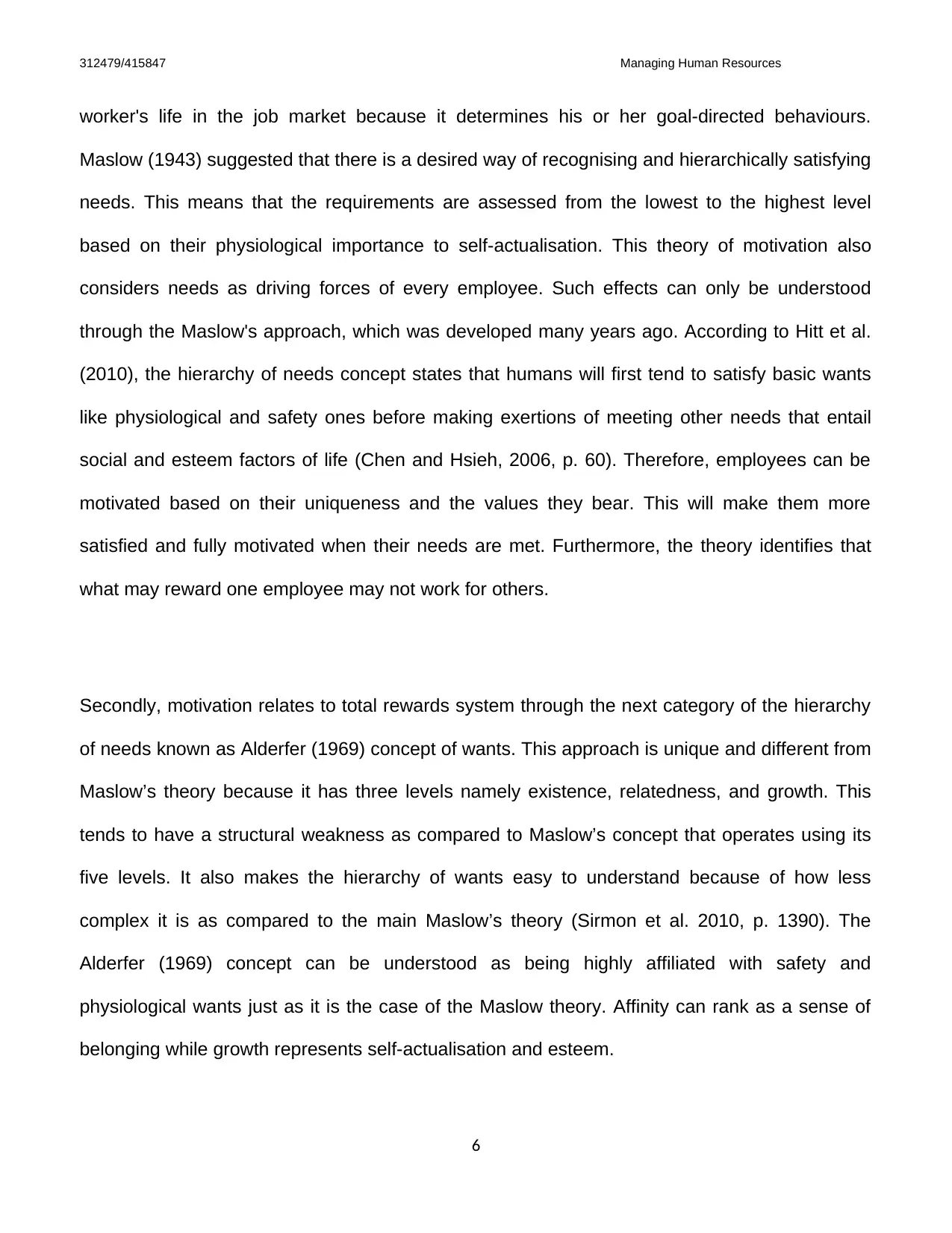
312479/415847 Managing Human Resources
worker's life in the job market because it determines his or her goal-directed behaviours.
Maslow (1943) suggested that there is a desired way of recognising and hierarchically satisfying
needs. This means that the requirements are assessed from the lowest to the highest level
based on their physiological importance to self-actualisation. This theory of motivation also
considers needs as driving forces of every employee. Such effects can only be understood
through the Maslow's approach, which was developed many years ago. According to Hitt et al.
(2010), the hierarchy of needs concept states that humans will first tend to satisfy basic wants
like physiological and safety ones before making exertions of meeting other needs that entail
social and esteem factors of life (Chen and Hsieh, 2006, p. 60). Therefore, employees can be
motivated based on their uniqueness and the values they bear. This will make them more
satisfied and fully motivated when their needs are met. Furthermore, the theory identifies that
what may reward one employee may not work for others.
Secondly, motivation relates to total rewards system through the next category of the hierarchy
of needs known as Alderfer (1969) concept of wants. This approach is unique and different from
Maslow’s theory because it has three levels namely existence, relatedness, and growth. This
tends to have a structural weakness as compared to Maslow’s concept that operates using its
five levels. It also makes the hierarchy of wants easy to understand because of how less
complex it is as compared to the main Maslow’s theory (Sirmon et al. 2010, p. 1390). The
Alderfer (1969) concept can be understood as being highly affiliated with safety and
physiological wants just as it is the case of the Maslow theory. Affinity can rank as a sense of
belonging while growth represents self-actualisation and esteem.
6
worker's life in the job market because it determines his or her goal-directed behaviours.
Maslow (1943) suggested that there is a desired way of recognising and hierarchically satisfying
needs. This means that the requirements are assessed from the lowest to the highest level
based on their physiological importance to self-actualisation. This theory of motivation also
considers needs as driving forces of every employee. Such effects can only be understood
through the Maslow's approach, which was developed many years ago. According to Hitt et al.
(2010), the hierarchy of needs concept states that humans will first tend to satisfy basic wants
like physiological and safety ones before making exertions of meeting other needs that entail
social and esteem factors of life (Chen and Hsieh, 2006, p. 60). Therefore, employees can be
motivated based on their uniqueness and the values they bear. This will make them more
satisfied and fully motivated when their needs are met. Furthermore, the theory identifies that
what may reward one employee may not work for others.
Secondly, motivation relates to total rewards system through the next category of the hierarchy
of needs known as Alderfer (1969) concept of wants. This approach is unique and different from
Maslow’s theory because it has three levels namely existence, relatedness, and growth. This
tends to have a structural weakness as compared to Maslow’s concept that operates using its
five levels. It also makes the hierarchy of wants easy to understand because of how less
complex it is as compared to the main Maslow’s theory (Sirmon et al. 2010, p. 1390). The
Alderfer (1969) concept can be understood as being highly affiliated with safety and
physiological wants just as it is the case of the Maslow theory. Affinity can rank as a sense of
belonging while growth represents self-actualisation and esteem.
6
⊘ This is a preview!⊘
Do you want full access?
Subscribe today to unlock all pages.

Trusted by 1+ million students worldwide
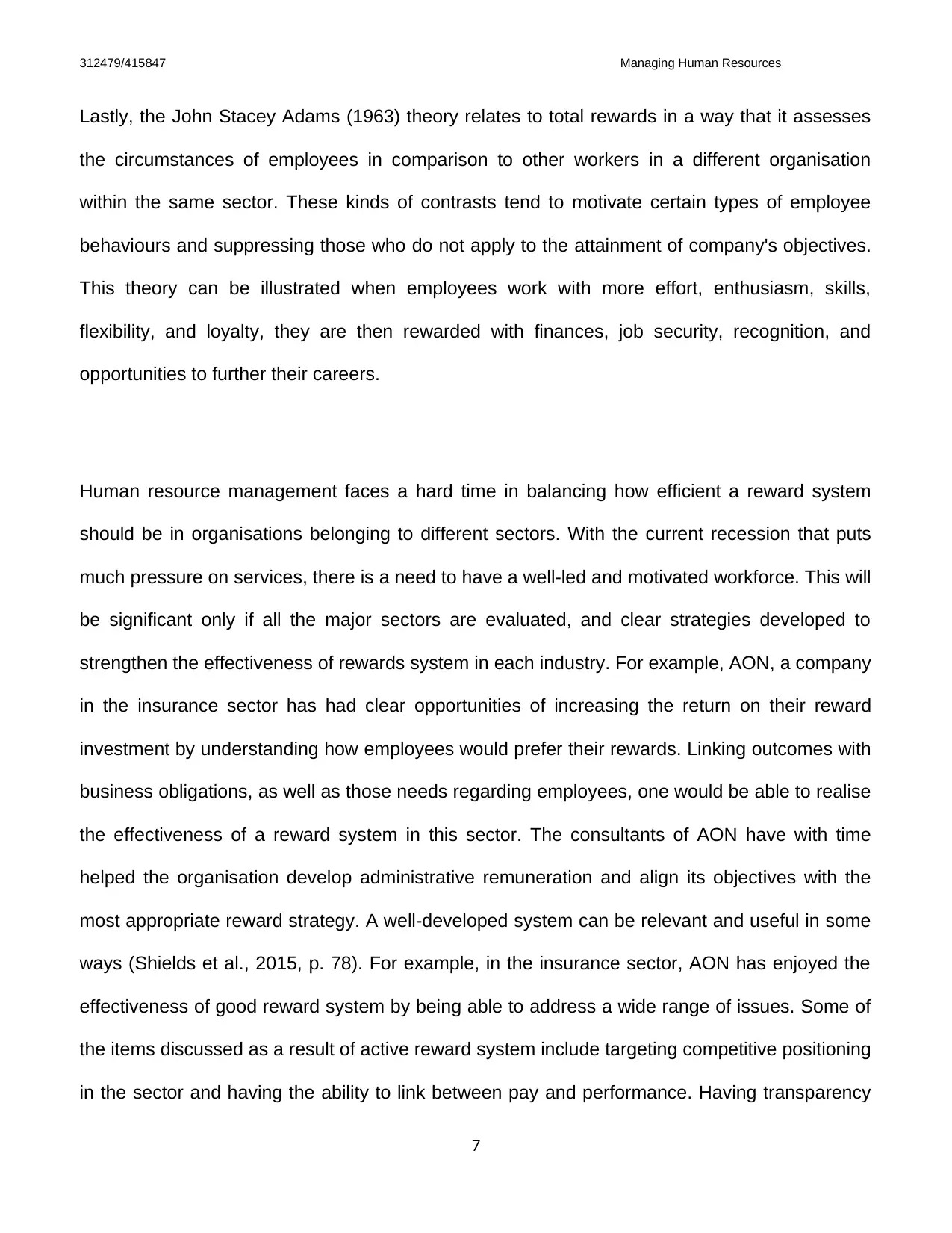
312479/415847 Managing Human Resources
Lastly, the John Stacey Adams (1963) theory relates to total rewards in a way that it assesses
the circumstances of employees in comparison to other workers in a different organisation
within the same sector. These kinds of contrasts tend to motivate certain types of employee
behaviours and suppressing those who do not apply to the attainment of company's objectives.
This theory can be illustrated when employees work with more effort, enthusiasm, skills,
flexibility, and loyalty, they are then rewarded with finances, job security, recognition, and
opportunities to further their careers.
Human resource management faces a hard time in balancing how efficient a reward system
should be in organisations belonging to different sectors. With the current recession that puts
much pressure on services, there is a need to have a well-led and motivated workforce. This will
be significant only if all the major sectors are evaluated, and clear strategies developed to
strengthen the effectiveness of rewards system in each industry. For example, AON, a company
in the insurance sector has had clear opportunities of increasing the return on their reward
investment by understanding how employees would prefer their rewards. Linking outcomes with
business obligations, as well as those needs regarding employees, one would be able to realise
the effectiveness of a reward system in this sector. The consultants of AON have with time
helped the organisation develop administrative remuneration and align its objectives with the
most appropriate reward strategy. A well-developed system can be relevant and useful in some
ways (Shields et al., 2015, p. 78). For example, in the insurance sector, AON has enjoyed the
effectiveness of good reward system by being able to address a wide range of issues. Some of
the items discussed as a result of active reward system include targeting competitive positioning
in the sector and having the ability to link between pay and performance. Having transparency
7
Lastly, the John Stacey Adams (1963) theory relates to total rewards in a way that it assesses
the circumstances of employees in comparison to other workers in a different organisation
within the same sector. These kinds of contrasts tend to motivate certain types of employee
behaviours and suppressing those who do not apply to the attainment of company's objectives.
This theory can be illustrated when employees work with more effort, enthusiasm, skills,
flexibility, and loyalty, they are then rewarded with finances, job security, recognition, and
opportunities to further their careers.
Human resource management faces a hard time in balancing how efficient a reward system
should be in organisations belonging to different sectors. With the current recession that puts
much pressure on services, there is a need to have a well-led and motivated workforce. This will
be significant only if all the major sectors are evaluated, and clear strategies developed to
strengthen the effectiveness of rewards system in each industry. For example, AON, a company
in the insurance sector has had clear opportunities of increasing the return on their reward
investment by understanding how employees would prefer their rewards. Linking outcomes with
business obligations, as well as those needs regarding employees, one would be able to realise
the effectiveness of a reward system in this sector. The consultants of AON have with time
helped the organisation develop administrative remuneration and align its objectives with the
most appropriate reward strategy. A well-developed system can be relevant and useful in some
ways (Shields et al., 2015, p. 78). For example, in the insurance sector, AON has enjoyed the
effectiveness of good reward system by being able to address a wide range of issues. Some of
the items discussed as a result of active reward system include targeting competitive positioning
in the sector and having the ability to link between pay and performance. Having transparency
7
Paraphrase This Document
Need a fresh take? Get an instant paraphrase of this document with our AI Paraphraser
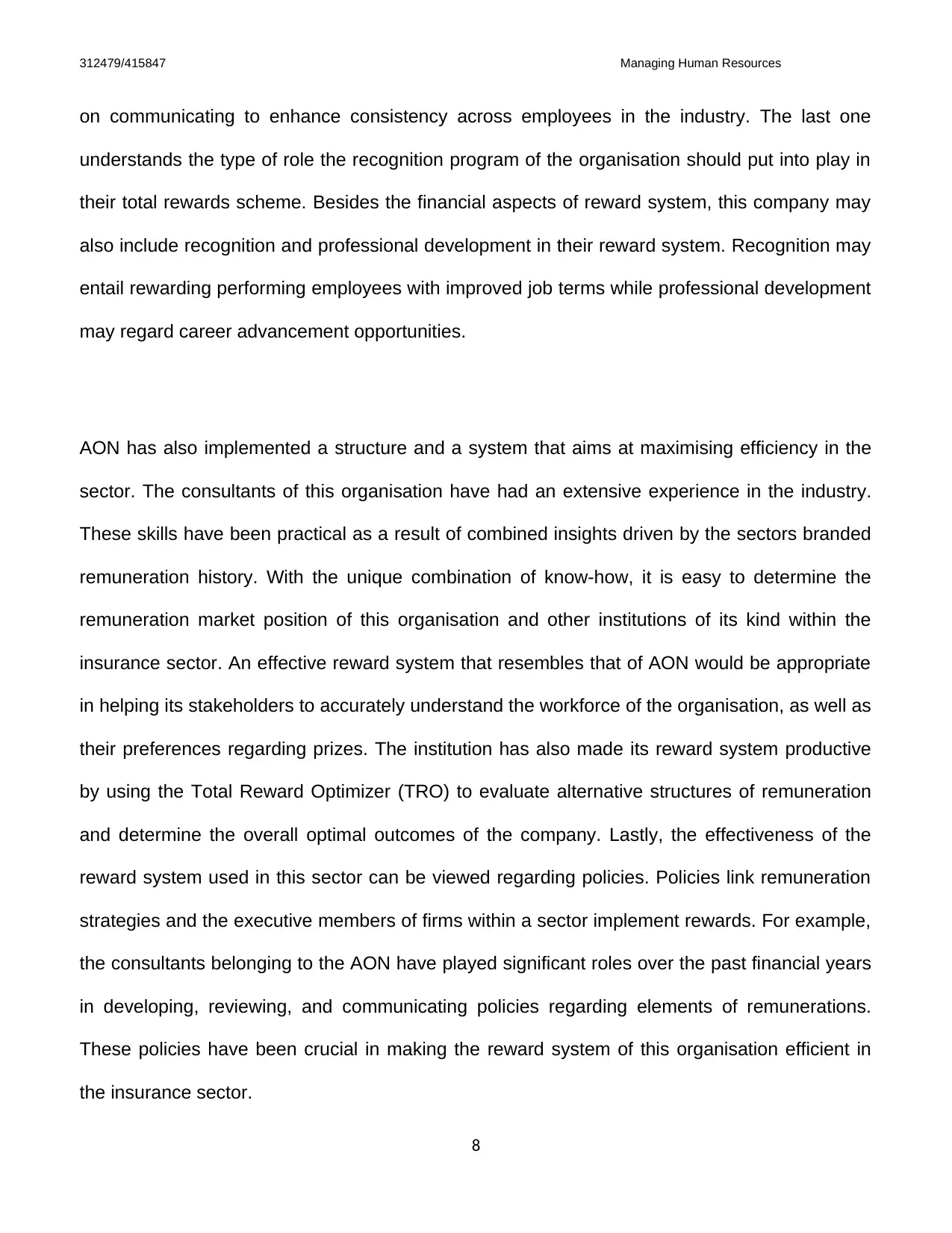
312479/415847 Managing Human Resources
on communicating to enhance consistency across employees in the industry. The last one
understands the type of role the recognition program of the organisation should put into play in
their total rewards scheme. Besides the financial aspects of reward system, this company may
also include recognition and professional development in their reward system. Recognition may
entail rewarding performing employees with improved job terms while professional development
may regard career advancement opportunities.
AON has also implemented a structure and a system that aims at maximising efficiency in the
sector. The consultants of this organisation have had an extensive experience in the industry.
These skills have been practical as a result of combined insights driven by the sectors branded
remuneration history. With the unique combination of know-how, it is easy to determine the
remuneration market position of this organisation and other institutions of its kind within the
insurance sector. An effective reward system that resembles that of AON would be appropriate
in helping its stakeholders to accurately understand the workforce of the organisation, as well as
their preferences regarding prizes. The institution has also made its reward system productive
by using the Total Reward Optimizer (TRO) to evaluate alternative structures of remuneration
and determine the overall optimal outcomes of the company. Lastly, the effectiveness of the
reward system used in this sector can be viewed regarding policies. Policies link remuneration
strategies and the executive members of firms within a sector implement rewards. For example,
the consultants belonging to the AON have played significant roles over the past financial years
in developing, reviewing, and communicating policies regarding elements of remunerations.
These policies have been crucial in making the reward system of this organisation efficient in
the insurance sector.
8
on communicating to enhance consistency across employees in the industry. The last one
understands the type of role the recognition program of the organisation should put into play in
their total rewards scheme. Besides the financial aspects of reward system, this company may
also include recognition and professional development in their reward system. Recognition may
entail rewarding performing employees with improved job terms while professional development
may regard career advancement opportunities.
AON has also implemented a structure and a system that aims at maximising efficiency in the
sector. The consultants of this organisation have had an extensive experience in the industry.
These skills have been practical as a result of combined insights driven by the sectors branded
remuneration history. With the unique combination of know-how, it is easy to determine the
remuneration market position of this organisation and other institutions of its kind within the
insurance sector. An effective reward system that resembles that of AON would be appropriate
in helping its stakeholders to accurately understand the workforce of the organisation, as well as
their preferences regarding prizes. The institution has also made its reward system productive
by using the Total Reward Optimizer (TRO) to evaluate alternative structures of remuneration
and determine the overall optimal outcomes of the company. Lastly, the effectiveness of the
reward system used in this sector can be viewed regarding policies. Policies link remuneration
strategies and the executive members of firms within a sector implement rewards. For example,
the consultants belonging to the AON have played significant roles over the past financial years
in developing, reviewing, and communicating policies regarding elements of remunerations.
These policies have been crucial in making the reward system of this organisation efficient in
the insurance sector.
8
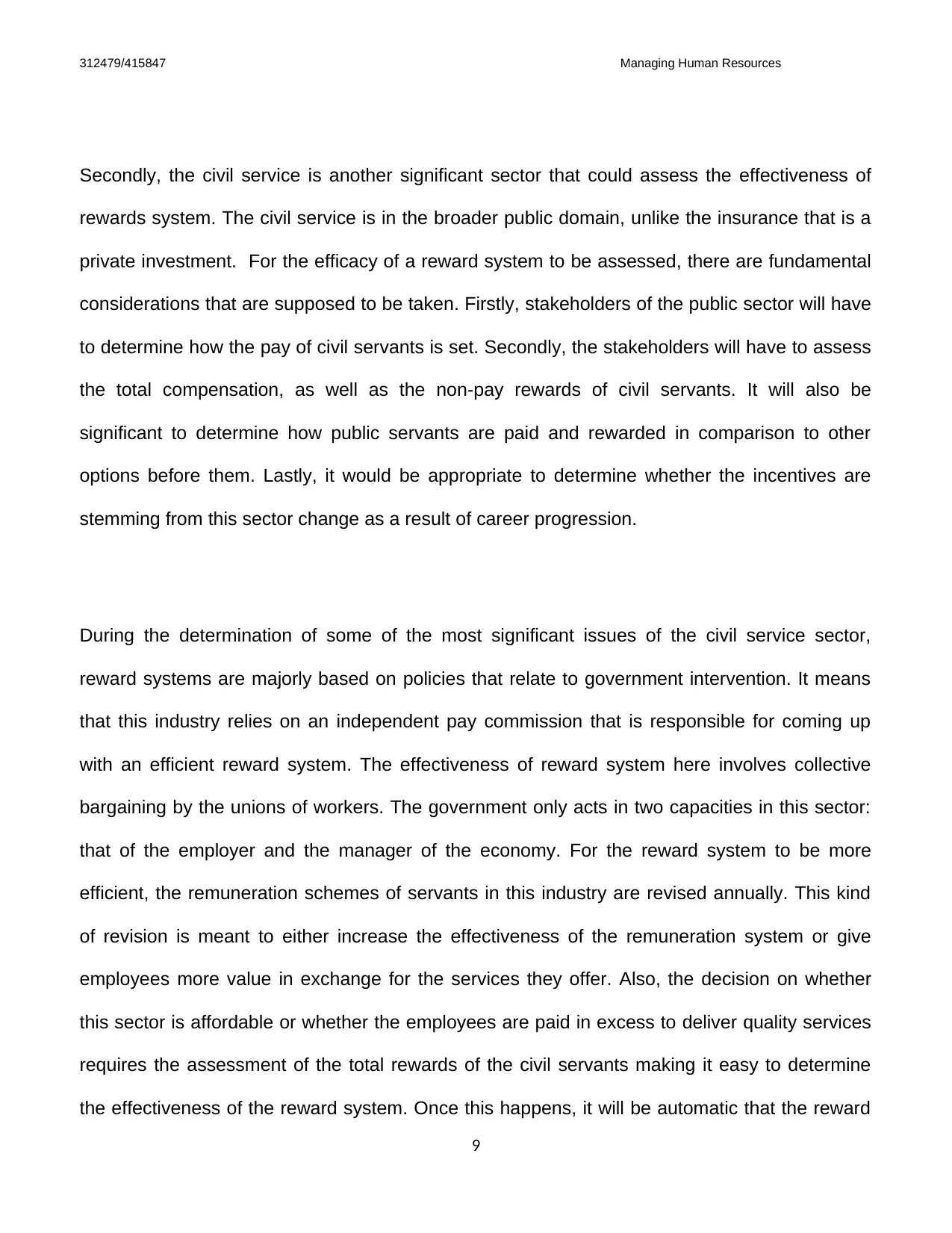
312479/415847 Managing Human Resources
Secondly, the civil service is another significant sector that could assess the effectiveness of
rewards system. The civil service is in the broader public domain, unlike the insurance that is a
private investment. For the efficacy of a reward system to be assessed, there are fundamental
considerations that are supposed to be taken. Firstly, stakeholders of the public sector will have
to determine how the pay of civil servants is set. Secondly, the stakeholders will have to assess
the total compensation, as well as the non-pay rewards of civil servants. It will also be
significant to determine how public servants are paid and rewarded in comparison to other
options before them. Lastly, it would be appropriate to determine whether the incentives are
stemming from this sector change as a result of career progression.
During the determination of some of the most significant issues of the civil service sector,
reward systems are majorly based on policies that relate to government intervention. It means
that this industry relies on an independent pay commission that is responsible for coming up
with an efficient reward system. The effectiveness of reward system here involves collective
bargaining by the unions of workers. The government only acts in two capacities in this sector:
that of the employer and the manager of the economy. For the reward system to be more
efficient, the remuneration schemes of servants in this industry are revised annually. This kind
of revision is meant to either increase the effectiveness of the remuneration system or give
employees more value in exchange for the services they offer. Also, the decision on whether
this sector is affordable or whether the employees are paid in excess to deliver quality services
requires the assessment of the total rewards of the civil servants making it easy to determine
the effectiveness of the reward system. Once this happens, it will be automatic that the reward
9
Secondly, the civil service is another significant sector that could assess the effectiveness of
rewards system. The civil service is in the broader public domain, unlike the insurance that is a
private investment. For the efficacy of a reward system to be assessed, there are fundamental
considerations that are supposed to be taken. Firstly, stakeholders of the public sector will have
to determine how the pay of civil servants is set. Secondly, the stakeholders will have to assess
the total compensation, as well as the non-pay rewards of civil servants. It will also be
significant to determine how public servants are paid and rewarded in comparison to other
options before them. Lastly, it would be appropriate to determine whether the incentives are
stemming from this sector change as a result of career progression.
During the determination of some of the most significant issues of the civil service sector,
reward systems are majorly based on policies that relate to government intervention. It means
that this industry relies on an independent pay commission that is responsible for coming up
with an efficient reward system. The effectiveness of reward system here involves collective
bargaining by the unions of workers. The government only acts in two capacities in this sector:
that of the employer and the manager of the economy. For the reward system to be more
efficient, the remuneration schemes of servants in this industry are revised annually. This kind
of revision is meant to either increase the effectiveness of the remuneration system or give
employees more value in exchange for the services they offer. Also, the decision on whether
this sector is affordable or whether the employees are paid in excess to deliver quality services
requires the assessment of the total rewards of the civil servants making it easy to determine
the effectiveness of the reward system. Once this happens, it will be automatic that the reward
9
⊘ This is a preview!⊘
Do you want full access?
Subscribe today to unlock all pages.

Trusted by 1+ million students worldwide
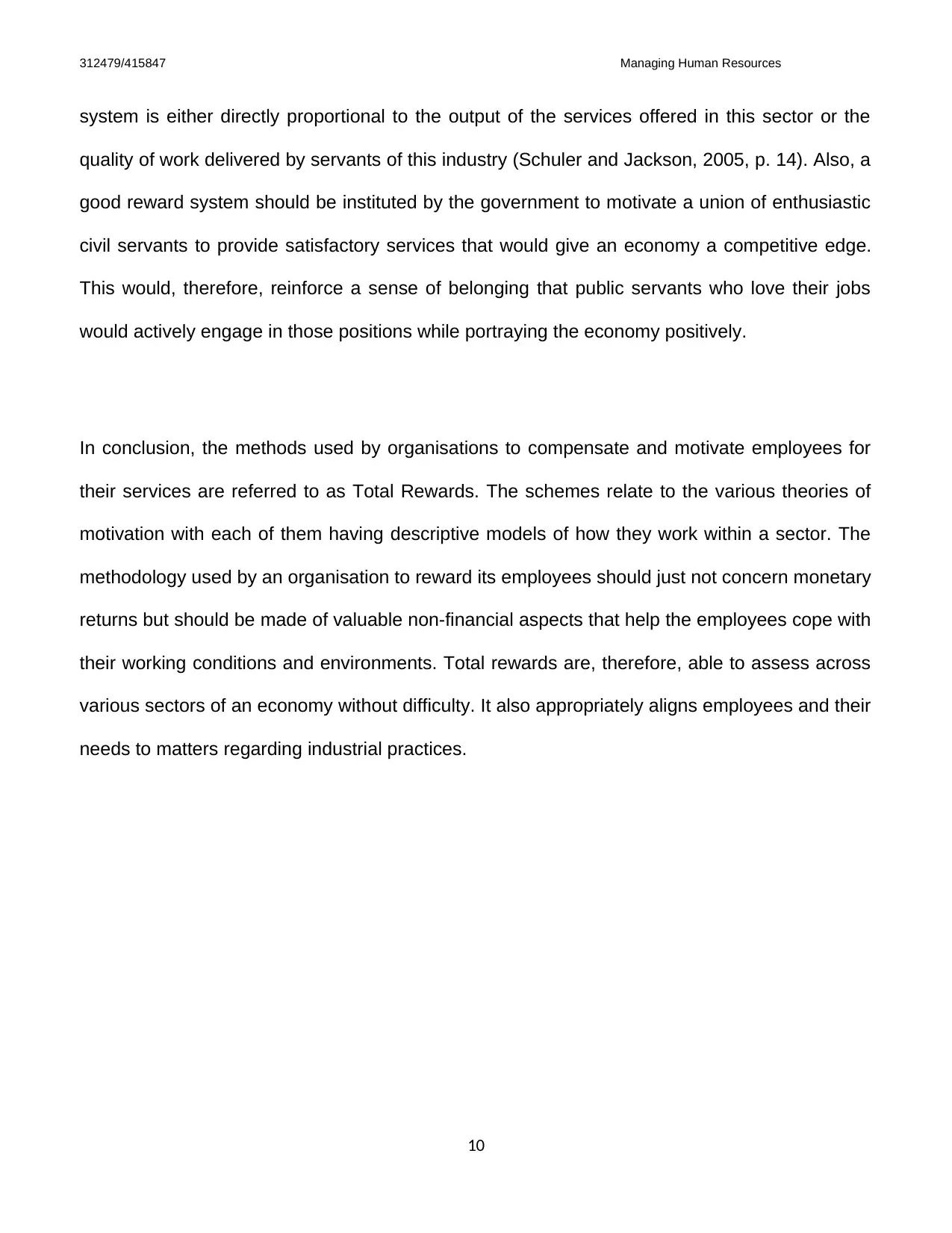
312479/415847 Managing Human Resources
system is either directly proportional to the output of the services offered in this sector or the
quality of work delivered by servants of this industry (Schuler and Jackson, 2005, p. 14). Also, a
good reward system should be instituted by the government to motivate a union of enthusiastic
civil servants to provide satisfactory services that would give an economy a competitive edge.
This would, therefore, reinforce a sense of belonging that public servants who love their jobs
would actively engage in those positions while portraying the economy positively.
In conclusion, the methods used by organisations to compensate and motivate employees for
their services are referred to as Total Rewards. The schemes relate to the various theories of
motivation with each of them having descriptive models of how they work within a sector. The
methodology used by an organisation to reward its employees should just not concern monetary
returns but should be made of valuable non-financial aspects that help the employees cope with
their working conditions and environments. Total rewards are, therefore, able to assess across
various sectors of an economy without difficulty. It also appropriately aligns employees and their
needs to matters regarding industrial practices.
10
system is either directly proportional to the output of the services offered in this sector or the
quality of work delivered by servants of this industry (Schuler and Jackson, 2005, p. 14). Also, a
good reward system should be instituted by the government to motivate a union of enthusiastic
civil servants to provide satisfactory services that would give an economy a competitive edge.
This would, therefore, reinforce a sense of belonging that public servants who love their jobs
would actively engage in those positions while portraying the economy positively.
In conclusion, the methods used by organisations to compensate and motivate employees for
their services are referred to as Total Rewards. The schemes relate to the various theories of
motivation with each of them having descriptive models of how they work within a sector. The
methodology used by an organisation to reward its employees should just not concern monetary
returns but should be made of valuable non-financial aspects that help the employees cope with
their working conditions and environments. Total rewards are, therefore, able to assess across
various sectors of an economy without difficulty. It also appropriately aligns employees and their
needs to matters regarding industrial practices.
10
Paraphrase This Document
Need a fresh take? Get an instant paraphrase of this document with our AI Paraphraser
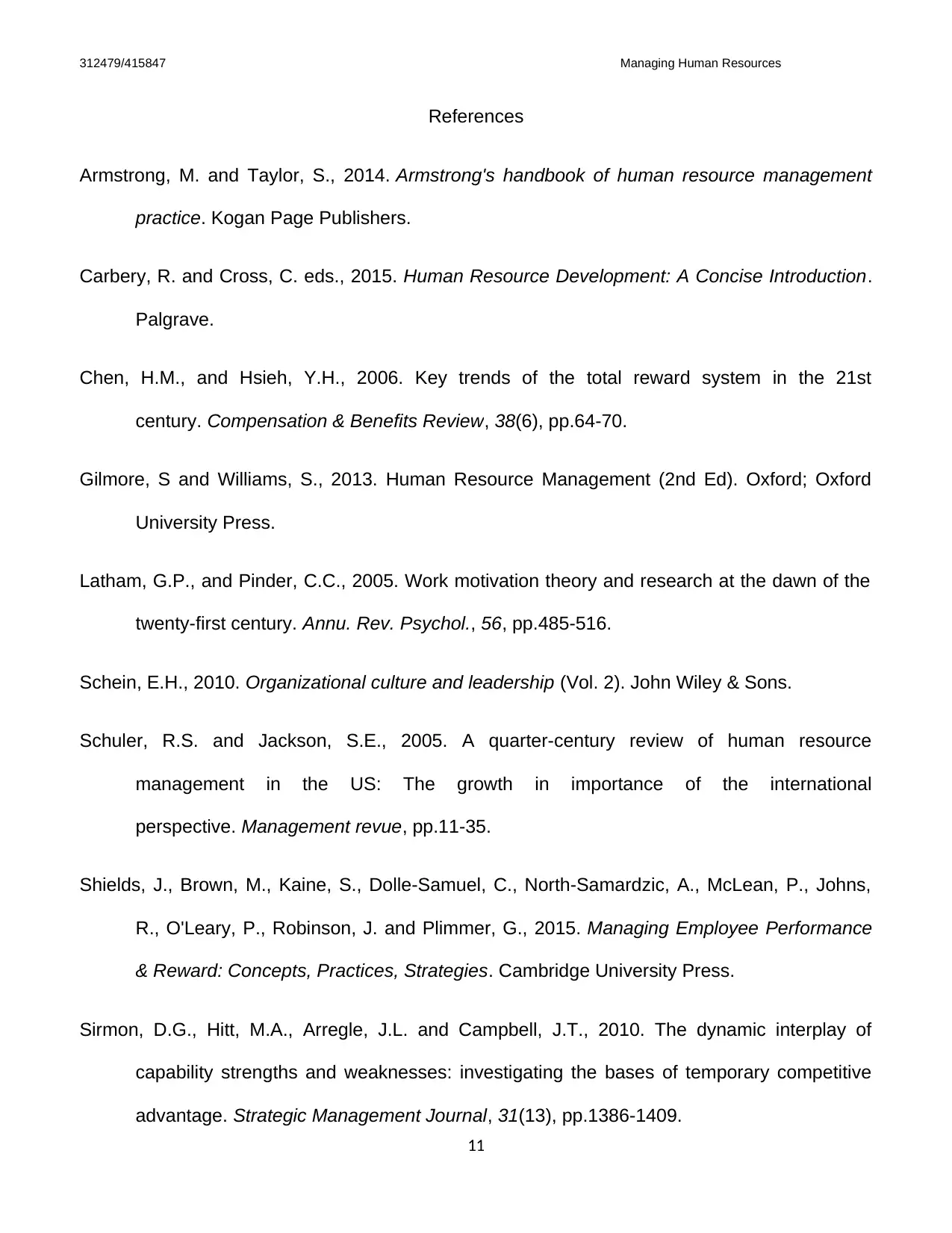
312479/415847 Managing Human Resources
References
Armstrong, M. and Taylor, S., 2014. Armstrong's handbook of human resource management
practice. Kogan Page Publishers.
Carbery, R. and Cross, C. eds., 2015. Human Resource Development: A Concise Introduction.
Palgrave.
Chen, H.M., and Hsieh, Y.H., 2006. Key trends of the total reward system in the 21st
century. Compensation & Benefits Review, 38(6), pp.64-70.
Gilmore, S and Williams, S., 2013. Human Resource Management (2nd Ed). Oxford; Oxford
University Press.
Latham, G.P., and Pinder, C.C., 2005. Work motivation theory and research at the dawn of the
twenty-first century. Annu. Rev. Psychol., 56, pp.485-516.
Schein, E.H., 2010. Organizational culture and leadership (Vol. 2). John Wiley & Sons.
Schuler, R.S. and Jackson, S.E., 2005. A quarter-century review of human resource
management in the US: The growth in importance of the international
perspective. Management revue, pp.11-35.
Shields, J., Brown, M., Kaine, S., Dolle-Samuel, C., North-Samardzic, A., McLean, P., Johns,
R., O'Leary, P., Robinson, J. and Plimmer, G., 2015. Managing Employee Performance
& Reward: Concepts, Practices, Strategies. Cambridge University Press.
Sirmon, D.G., Hitt, M.A., Arregle, J.L. and Campbell, J.T., 2010. The dynamic interplay of
capability strengths and weaknesses: investigating the bases of temporary competitive
advantage. Strategic Management Journal, 31(13), pp.1386-1409.
11
References
Armstrong, M. and Taylor, S., 2014. Armstrong's handbook of human resource management
practice. Kogan Page Publishers.
Carbery, R. and Cross, C. eds., 2015. Human Resource Development: A Concise Introduction.
Palgrave.
Chen, H.M., and Hsieh, Y.H., 2006. Key trends of the total reward system in the 21st
century. Compensation & Benefits Review, 38(6), pp.64-70.
Gilmore, S and Williams, S., 2013. Human Resource Management (2nd Ed). Oxford; Oxford
University Press.
Latham, G.P., and Pinder, C.C., 2005. Work motivation theory and research at the dawn of the
twenty-first century. Annu. Rev. Psychol., 56, pp.485-516.
Schein, E.H., 2010. Organizational culture and leadership (Vol. 2). John Wiley & Sons.
Schuler, R.S. and Jackson, S.E., 2005. A quarter-century review of human resource
management in the US: The growth in importance of the international
perspective. Management revue, pp.11-35.
Shields, J., Brown, M., Kaine, S., Dolle-Samuel, C., North-Samardzic, A., McLean, P., Johns,
R., O'Leary, P., Robinson, J. and Plimmer, G., 2015. Managing Employee Performance
& Reward: Concepts, Practices, Strategies. Cambridge University Press.
Sirmon, D.G., Hitt, M.A., Arregle, J.L. and Campbell, J.T., 2010. The dynamic interplay of
capability strengths and weaknesses: investigating the bases of temporary competitive
advantage. Strategic Management Journal, 31(13), pp.1386-1409.
11
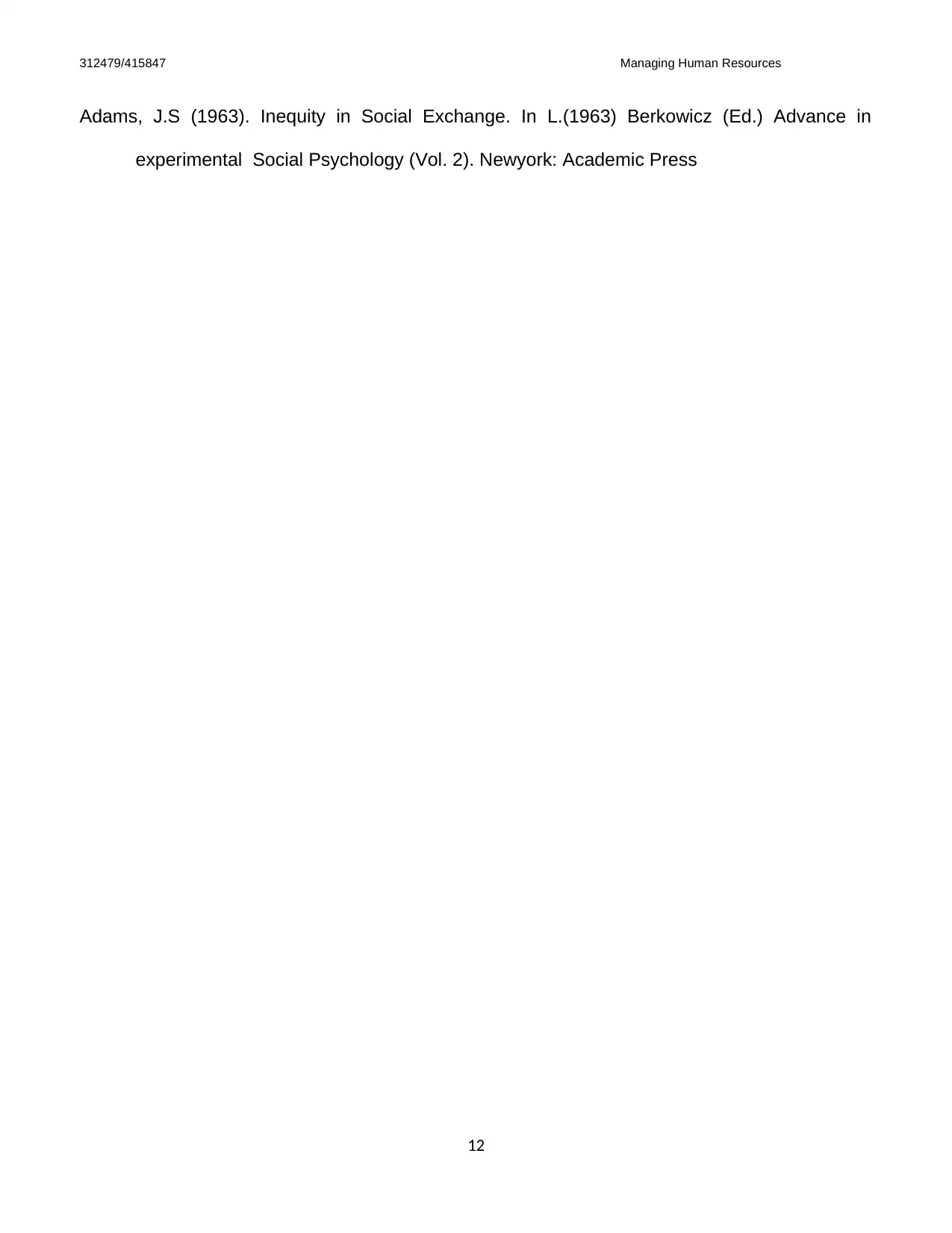
312479/415847 Managing Human Resources
Adams, J.S (1963). Inequity in Social Exchange. In L.(1963) Berkowicz (Ed.) Advance in
experimental Social Psychology (Vol. 2). Newyork: Academic Press
12
Adams, J.S (1963). Inequity in Social Exchange. In L.(1963) Berkowicz (Ed.) Advance in
experimental Social Psychology (Vol. 2). Newyork: Academic Press
12
⊘ This is a preview!⊘
Do you want full access?
Subscribe today to unlock all pages.

Trusted by 1+ million students worldwide
1 out of 12
Related Documents
Your All-in-One AI-Powered Toolkit for Academic Success.
+13062052269
info@desklib.com
Available 24*7 on WhatsApp / Email
![[object Object]](/_next/static/media/star-bottom.7253800d.svg)
Unlock your academic potential
Copyright © 2020–2025 A2Z Services. All Rights Reserved. Developed and managed by ZUCOL.





